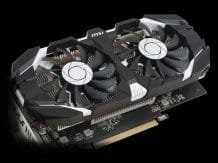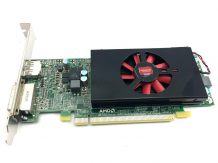How to increase the performance of a laptop/ Intel Core i7-11800H – undervolting and overclocking – Such a device is Dream Machines RG3050Ti-15PL26 with an almost top (but very limited) Core i7-11800H and a rather poor RTX 3050 Ti. On its example, we will show how to significantly, and most importantly for free, increase the performance of the CPU and GPU.
- Laptops equipped with the same components may significantly differ in performance, which is influenced, for example, by power limits or the efficiency of the cooling system.
- Dream Machines RG3050Ti-15PL26, although equipped with an almost top Intel Core i7-11800H processor, unfortunately in many applications provides lower performance than other devices with the same CPU.
- In the case of many devices with Intel processors, however, we have the option of lowering the CPU voltage (undervolting), which will ensure lower CPU temperatures or allow you to maintain higher performance.
- Another way to increase processor performance is to raise the power limit, but this may involve a significant increase in the amount of heat generated.
- Although the Core i7-11800H has a locked multiplier, in the Dream Machines laptop we have the option of increasing the maximum CPU clock while all cores are loaded.
- Another easy and virtually flawless way to increase gaming laptop performance is to increase the GPU and VRAM clock speeds.
- These methods allow you to noticeably increase the performance of your laptop – from a few to even several dozen percent!
- More such topics can be found on the main page of Onet.pl
Dream Machines RG3050Ti-15PL26 – default configuration and operation of the processor
As our tests have shown, the Core i7-11800H in the RG3050Ti-15PL26 performs weaker both in short, but especially in longer, multi-threaded applications than an identical processor, e.g. in the Acer Predator Helios 300 . This is due to two factors: temporary overheating of the CPU and a low long-term power limit.
Core i7-11800H default TDP is standard 45W. However, especially in the case of laptops, the actual processor power is determined by the energy limits set by the device manufacturer. In the case of the RG3050Ti-15PL26 in the Performance mode (on which we conducted all tests), the long-term power limit (PL1) is 60W and it can temporarily be exceeded up to the short-term power limit (PL2) of 135W . However, it can take a certain amount of time (Tau), in this case as little as 48 seconds , after which the CPU power must be reduced to PL1.
As a reminder, in the Acera Predator Helios 300, the identical system could operate with a long-lasting power of 70W, while in Legion 5, the long-term power limit for Ryzen 7 5800H is 88W
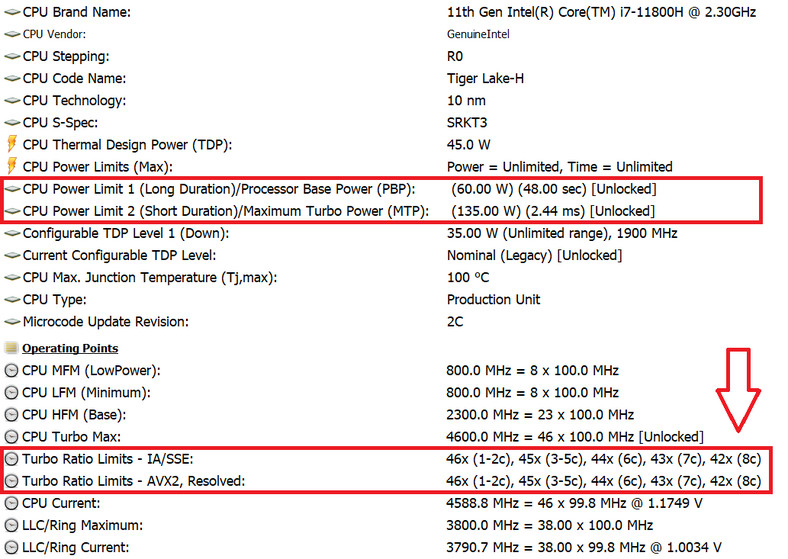
In practice, when rendering a scene in Blender, right after starting the test, the average clock speed of all CPU cores drops to the level of 4.2 GHz (i.e. the maximum value for multithreaded tasks), and the processor power increases to over 101W at a voltage of about 1.13-1, 2V . Therefore (and the cooling system fans are rather sluggish) , the CPU temperature increases quickly and significantly, reaching 98-99 degrees Celsius . To protect the CPU from overheating and damage, the voltage and power, and hence the CPU clock speed, must be lowered (temperature throttling) to about 3.9-4.1 GHz (about 90W at 1.09V). Of course, such power still exceeds PL1, thereforeafter 48 seconds, the CPU power and voltage are reduced to the level of the long-term power throttling (energy throttling), i.e. 60W at 0.96V, which causes the frequency to drop to only 3.5 GHz. Unfortunately, such power and average clock speed much lower than the default 4.2 GHz are maintained until the end of the test, and the average temperature of the cores is around 76 degrees Celsius.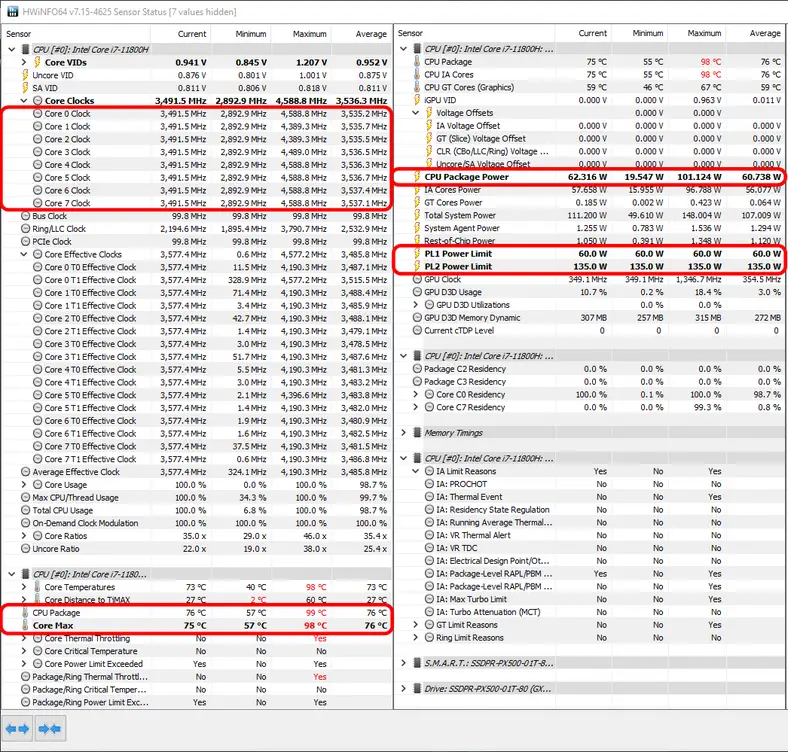
Photo: Mariusz Kolmer / Komputer Świat
Dream Machines RG3050Ti-15PL26 – Core i7-11800H default behavior when rendering scene in Blender
Dream Machines RG3050Ti-15PL26 – not a dream laptop at all
The laptop is equipped with a rather modest cooling system. Two thermally conductive tubes are responsible for cooling the graphics system. The narrower and shorter of them, via a copper plate, also dissipates heat from the GPU power section, and then connects to the single rear heat sink. The longer and much thicker tube, on the other hand, dissipates heat from both the GPU and partially from the CPU, and connects to a separate, side heat sink. Both heat sinks use a single, bi-directional fan. The heat from the processor is also dissipated by two narrow pipes, which are connected to a side, low, but wide heatsink, which is provided by a second, slightly larger fan. The plastic bottom panel is also quite well perforated (which, unfortunately, also bends significantly), so the access of cool air to the inside of the housing is quite decent.
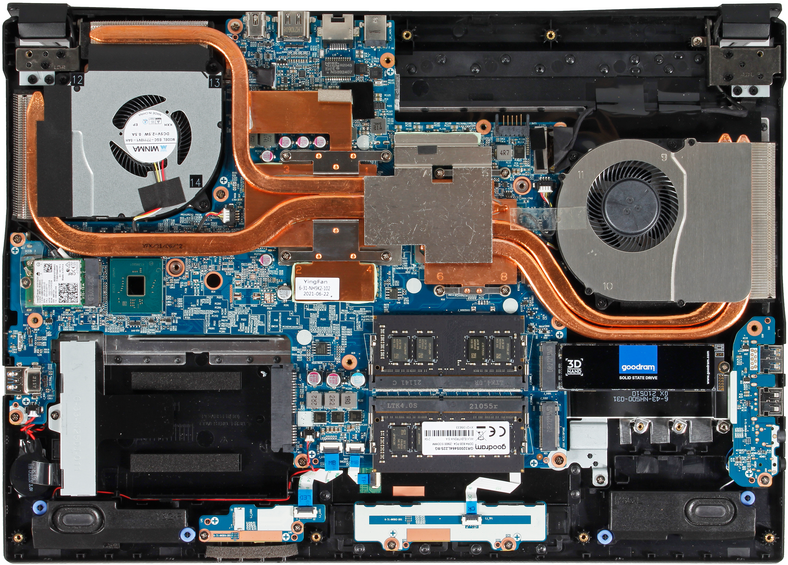
Unfortunately, during the most strenuous tasks, although the fans turn on quite quickly and are loud, when the CPU can run at high power, the core temperature quickly reaches the mentioned 98-99 ° C. However, after lowering the power to 60W, the average temperature remains around 75-76 ° C. However, this is still a lot for a system with such a low power.
Intel Core i7-11800H – voltage reduction (undervolting)
How can you eliminate (or at least reduce) the previously described clock speed drops, and thus performance? There are two solutions: incurring a long-term power limit and / or undervolting, i.e. lowering the voltage (and thus the amount of heat emitted) with which the CPU operates. We have recently described both activities in the Core i5-11400F review, the efficiency of which we managed to increase by over 30%!
Unfortunately, increasing the power limits in laptops is more problematic and has many consequences that must be remembered – due to the compact design and smaller cooling system, laptops have limited ability to dissipate heat from the processor operating at higher power, which can lead to significant heating of components and the housing of the device . Therefore , before increasing the power limit, it is a good idea to first lower the voltage at which the CPU is running . Reducing the voltage offset causes the processor to operate at a lower voltage than the default at a given clock speed. As a result, it generates less heat or can maintain a higher clock speed within the same fixed power limit.Some laptops have the option of undervolting disabled. However, in the RG3050Ti-15PL26 we have such an option. We can use two XTU (Intel Extreme Tuning Utility) or ThrottleStop applications for this . We used the latter. Here is a quick step-by-step guide to lowering the CPU voltage in a laptop.
- 1. After downloading and starting the ThrottleStop program, click the small buttons marked FIVR.
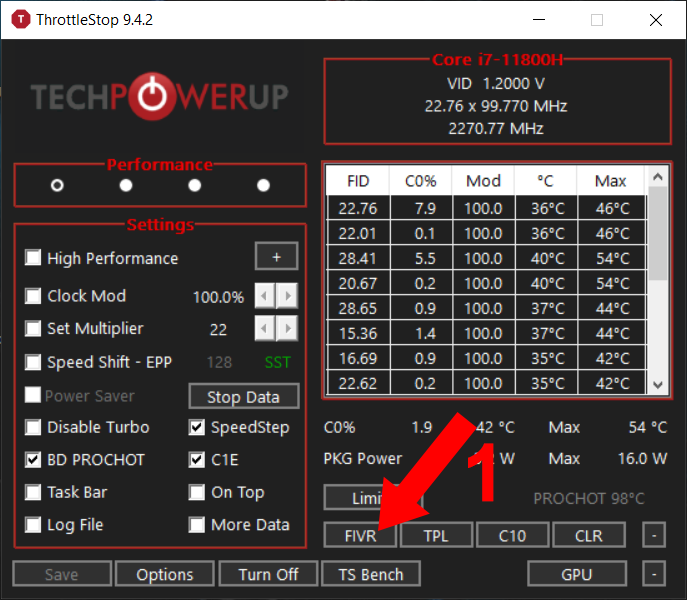
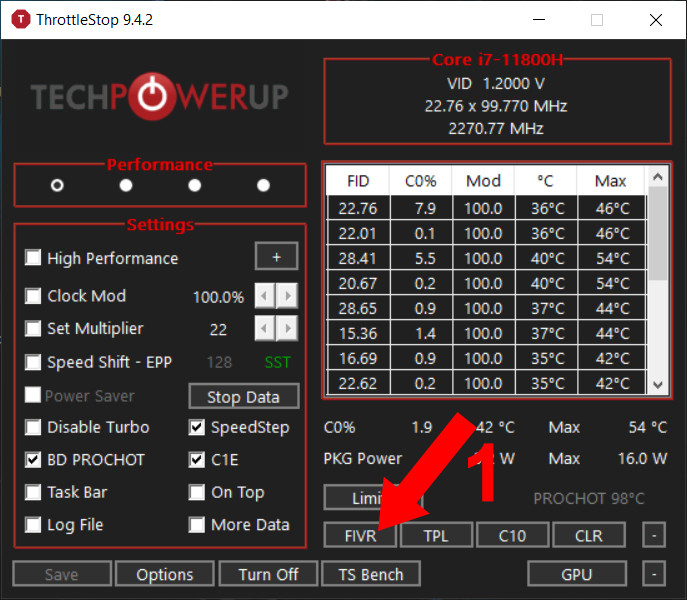
- 2. In the next window , in the FIVR Control section, select CPU Core.
- 3. Select Unlock Adjustable Voltage [leaving the following setting in the default Adaptive mode]
- 4. In the Offset Voltage field , use the slider or manually to reduce the CPU voltage offset. It is best to start at -0.05V (50mV) .
- 5. Click the Apply button in the lower right corner.
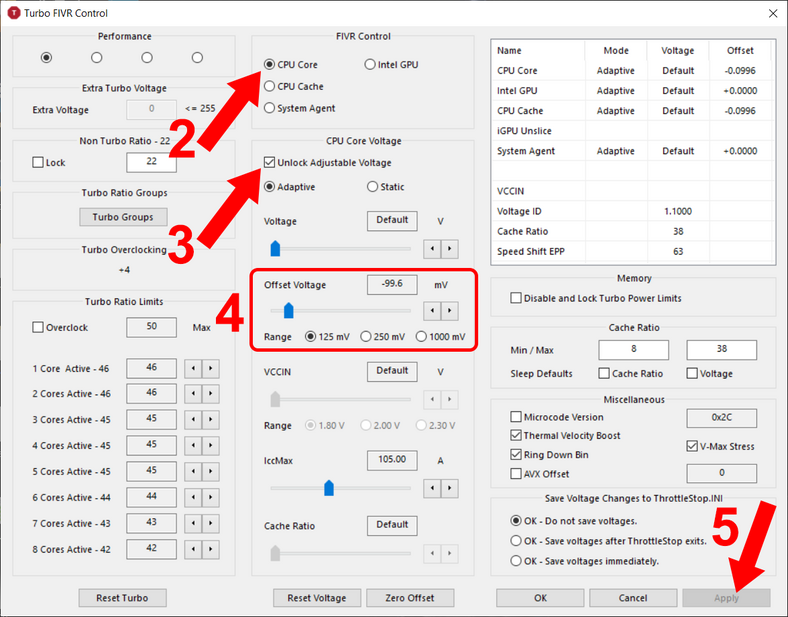
ThrottleStop – voltage offset reduction in the FIVR window
- 6. We check the stability of the processor. Rendering in Blender works well here, as it is highly stressful and sensitive to the stability of the processor.
- 7. If the processor is stable, lower the offset further; preferably in steps of 0.01V (10mV) , then re-test the stability.
- 8. In case the computer starts to freeze or reset, set the last value at which the laptop worked stably .
- 9. We can try to lower the offset further, but with greater precision, eg every 0.005V (5 mV), until the lowest, stable value is obtained.
- 10. The same way we can lower the CPU Cache voltage . However, in this case, often the possibility of reducing the offset is smaller.
In the case of Core i7-11800H in the test RG3050Ti-15PL26 , we managed to lower the voltage offset, both for the cores and for the cache, by as much as 0.1V . This during the load translated into a reduction of the maximum CPU power by about 10W, to the level of 91W at a voltage of 1.04V. Thus, it allowed to eliminate the initial temperature throttling. In the first 48 seconds (when the CPU is not limited by the PL1 limit), the CPU temperature reached 91 degrees Celsius and the CPU was able to consistently maintain the maximum default clock speed of 4.2 GHz. However, after this time and after lowering the limit to the PL1 level, i.e. 60W, the processor in the same power budget could maintain a higher clock speed, above 3.8 GHz(which previously required higher voltage and thus would exceed the power limit), and the temperature remained at an average of 74 degrees Celsius, so practically the same as before.
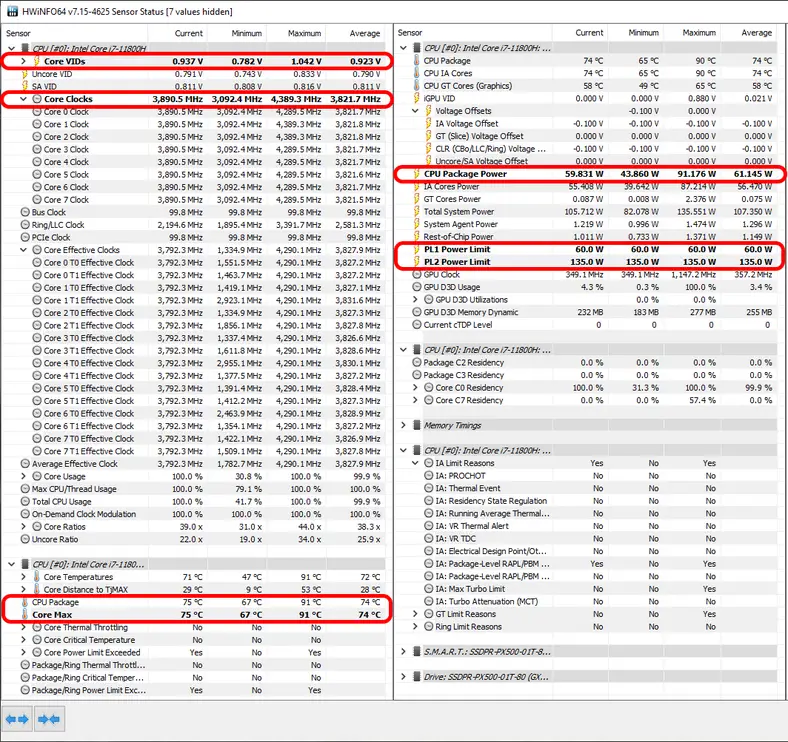
Intel Core i7-11800H – increased power limit
Unfortunately, even after undervolting, keeping the maximum clock speed of 4.2 GHz for longer than the mentioned 48 seconds is impossible, because the long-term power limit is still significantly exceeded . To allow the processor to run continuously at the officially maximum clock speed in the ThrottleStop application, we can raise the PL1. Here’s how to do it:
- 1. Run ThrottleStop and after setting the previously checked voltage offsets, click in the main window the button marked TPL (right next to the previous FIVR).
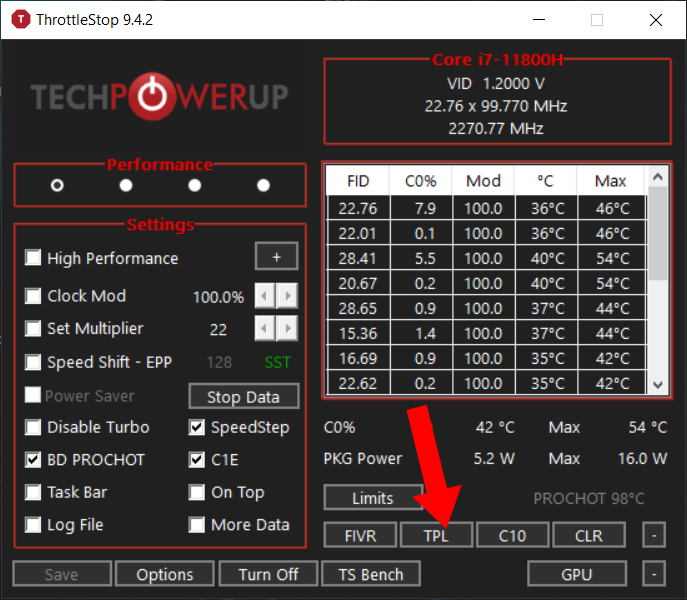
- 2. In the next window , in the Power Limit Control section, in the Long Power Limit window, enter the desired new value of PL1. We decided to set a limit equal to PL2, i.e. 135W.
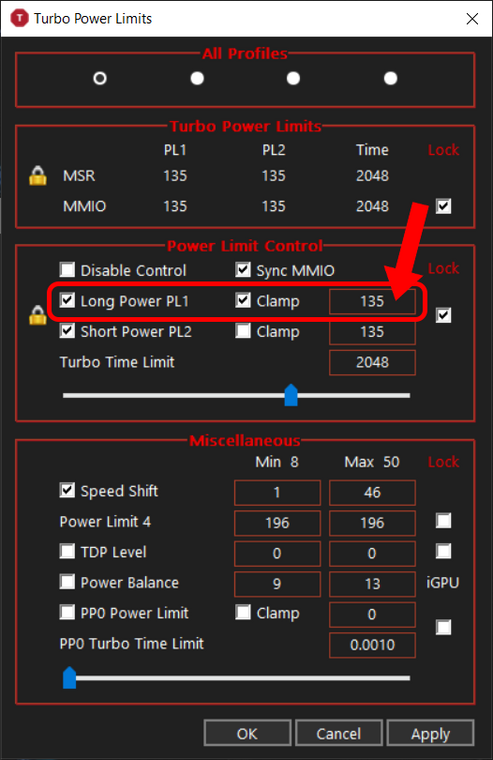
ThrottleStop – raising the long-term power limit in the TPL window
- 2a. In addition, in the Turbo Time Limit field, we can increase the time for which the limit can be exceeded (however, it is not necessary for now, because as we already know, the undervoltage processor does not exceed 100W).
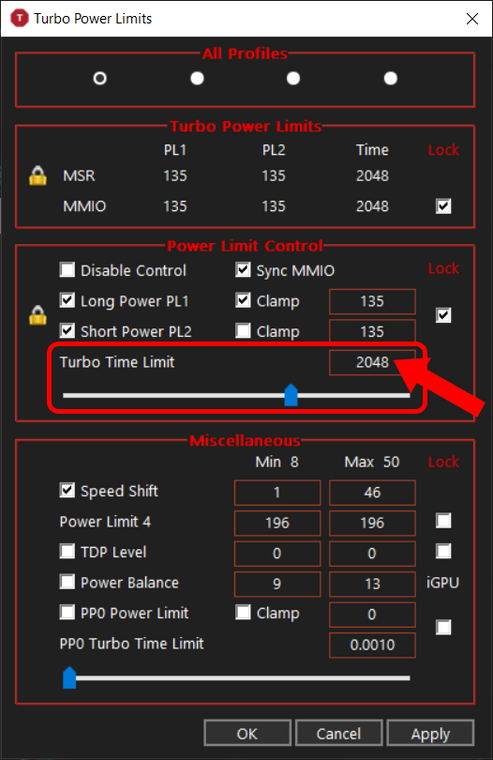
- 3. If we want the new limit to not be changed by other software, we can also select the Lock and Sync MIMO options .
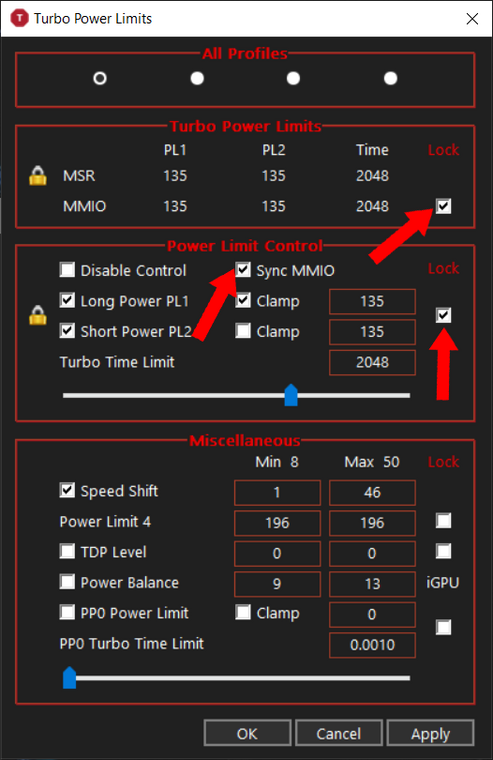
- 4. Click the Apply button in the lower right corner. And it’s ready 🙂
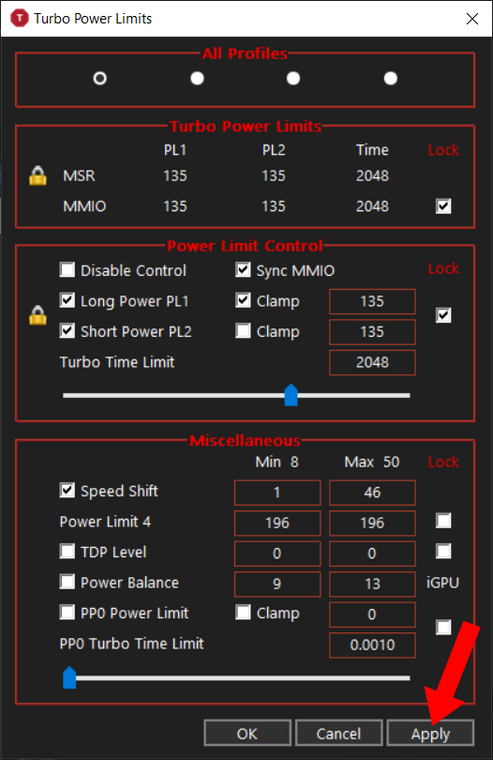
After setting the voltage offsets checked before and after raising the long-term power limit, the Core i7-11800H in the RG3050Ti-15PL26 was able to maintain the average clock speed of all cores at 4.18 GHz (i.e. slightly below the maximum 4, while rendering the scene in Blender). 2 GHz) with an average power of 85W and a voltage of 1.01V . Unfortunately, during long-term operation with an increased power limit, despite undervoltage and fans operating constantly at maximum speed, the cooling system was not able to effectively remove the heat emitted by the CPU. The maximum temperature of the cores reached 99 degrees Celsius (and there was a minimum temperature throttling and the clock temporarily dropped to 4.0 GHz), andthe average temperature from the entire test was as high as 96 degrees Celsius. Thus, if we are going to increase the processor power limit, we must make sure that the cooling system in our laptop is able to dissipate additional heat or we must use a cooling stand .
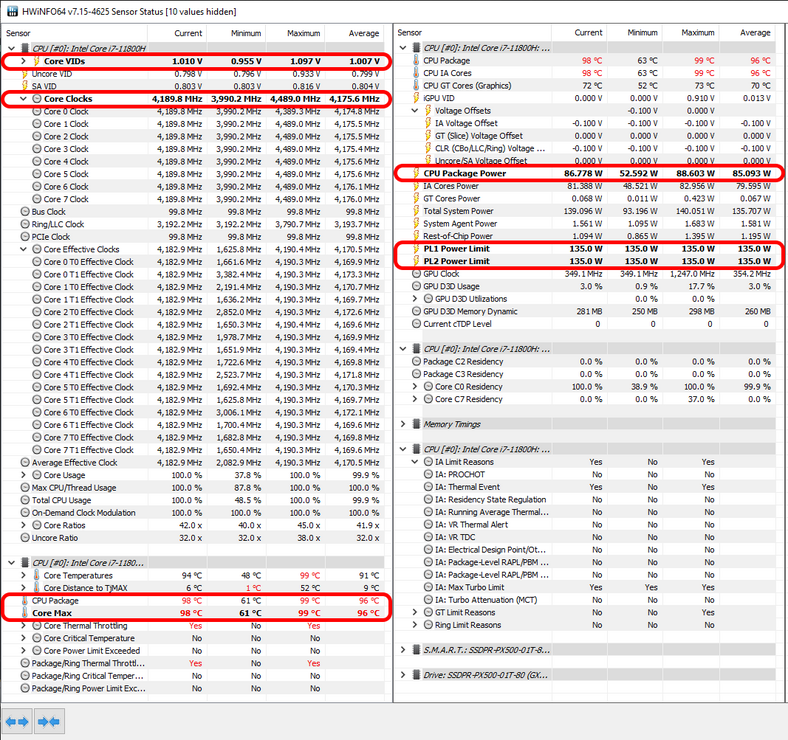
Dream Machines RG3050Ti-15PL26 – Core i7-11800H operating parameters after lowering the voltage offset and raising the PL1 limit
Intel Core i7-11800H – increasing the clock speed (overclocking)
However, these are still not all options to increase processor performance. In the case of the Core i7-11800H in the Dream Machines laptop, we also have the option of increasing the maximum clock speed when all cores are loaded! Although the processor does not belong to the K series, so it does not have an unlocked multiplier, in ThrottleStop we can increase the multiplier for all cores up to 50, which theoretically could give a clock speed of as much as 5 GHz. Here’s what to do:
- 1. In the FIVR Control window (after entering the previous settings of voltage offsets for the CPU and Cache) in the Turbo Ratio Limits section, select the Overclock option.
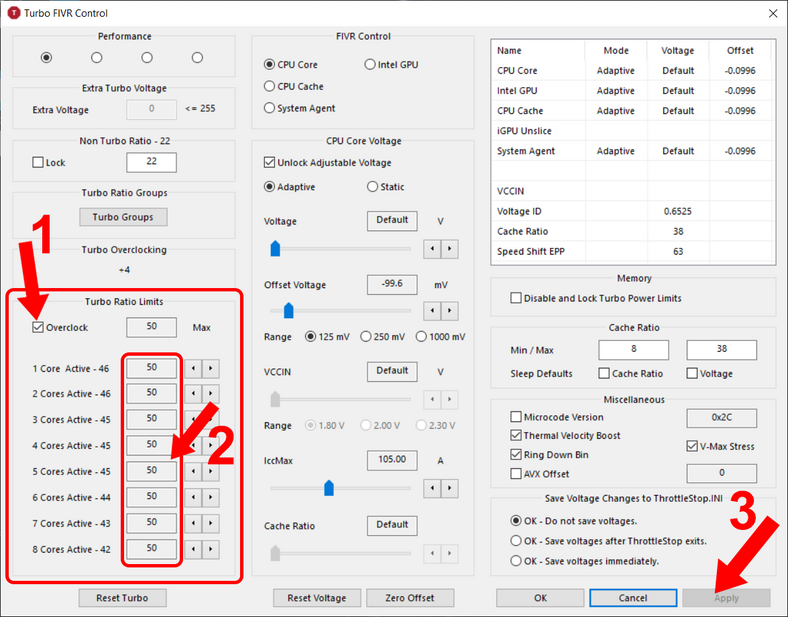
ThrottleStop – increasing the maximum clock speed when all cores are loaded
- 2. We set the multiplier values for all loaded cores to 50 .
- 3. Click the Apply button in the lower right corner.
- 4. Additionally, we can try to lower the voltage offsets for System Agent and Intel GPU – the method is the same as the lowering of voltage for CPU Core described earlier.
In practice, however, none of the cores can exceed the Intel-set maximum clock speed of 4.6 GHz . However, this is still noticeably higher than the default 4.2 GHz in all-core tasks. Unfortunately, in order for the processor to maintain 4.6 GHz on all cores during a load, the CPU supply voltage must already be high enough that even after reducing the voltage offset of the CPU Core, Cache, System Agent and Intel GPU, the processor will operate with much more power generating much more heat. So, for purely empirical purposes, to conduct tests, in this case we decided to remove the bottom panel of the housing and use an additional air supply of cooler air.
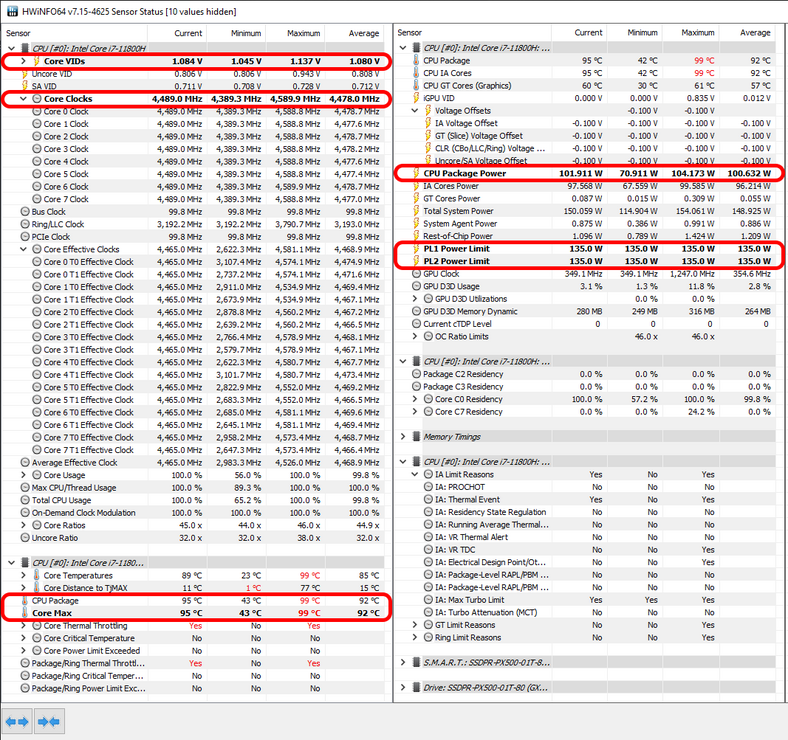
Dream Machines RG3050Ti-15PL26 – Core i7-11800H operating parameters after lowering the voltage offset, raising the PL1 limit and increasing the maximum clock speed
Even under these conditions and after lowering the voltage offset, raising the PL1 limit and increasing the maximum clock speed, the Core i7-11800H in the RG3050Ti-15PL26 was able to maintain a clock speed of 4.6 GHz while rendering the scene in Blender with power reaching 104W and a voltage of 1.14V just for a moment. Unfortunately, even the exposed cooling system with additional cooling air was not able to effectively remove such a large amount of heat emitted, and the maximum temperature of the CPU cores reached 99 degrees Celsius , which of course resulted in temperature throttling and temporary clock drops to 4.4 GHz.
However, the average clock speed of all cores throughout the test was 4.49 GHz(thus slightly below the maximum 4.6 GHz) with an average power of 100W and a voltage of 1.08V . Although the maximum temperature of the cores sometimes reached 99 degrees Celsius, due to the mentioned cooling improvement, the average temperature from the entire test was 92 degrees Celsius. It is a few degrees less than before the increase of the maximum clock speed, but it must be remembered that this test already required considerable interference in the construction of the laptop and the use of additional cooling , and was only intended to estimate the potential maximum power of the Core i7-11800H. We recommend this solution only to extreme overclocking enthusiasts;).
Intel Core i7-11800H – undervolting and overclocking – results in applications
In the case of single-threaded applications (when only one core is loaded), the CPU obviously does not exceed the power limits and generates a small amount of heat, so undervolting and lifting PL1 has no effect on performance . That’s why we focused exclusively on multi-threaded applications in our tests.
In the case of a short multi-file compression test with 7-zip , lowering the voltage offset and an additional increase in the power limit result in an identical performance gain compared to the default settings. The files are compressed in 4% less time , thanks to which the Core i7-11800H provides performance on the level of the desktop Core i7-11700K with a much higher power limit. This, despite all, is a modest increase in performance. This is due to the fact that during such short tests of the Core i7-11800H on Dream Machines RG3050Ti-15PL26 at the factory settings, it was able to maintain almost the maximum official clock speed for a short time, slightly reduced only due to rapid overheating and temperature throttling.A much better result is achieved by increasing the maximum clock speed to 4.6 GHz for all loaded cores. Thanks to this, the increase in performance reaches over 11% , which allows it to match the performance of the Ryzen 7 5800H, which is devoid of a similar overclocking option.
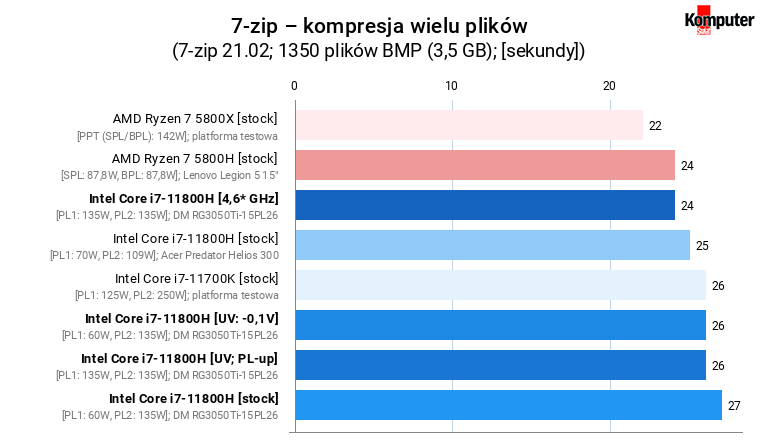
We observe a much greater increase in efficiency in another, although also relatively short, test. In Cinebench R23 MT, lowering the voltage (eliminating the initial CPU overheating) and increasing the power limit result in an 8% and 9% increase in performance , respectively, thanks to which the Dream Machines laptop not only significantly exceeds the performance of the Legion 5 with the competing Ryzen 7 5800H, but also slightly ahead of the Helios 300 equipped with the same processor. On the other hand, increasing the maximum clock speed to 4.6 GHz results in an over 15% increase in performance, and the processor manages to get a result of over 15,000 points! This provides higher performance than the desktop Core i7-11700K offers and not much lower than that of the Ryzen 7 5800X!
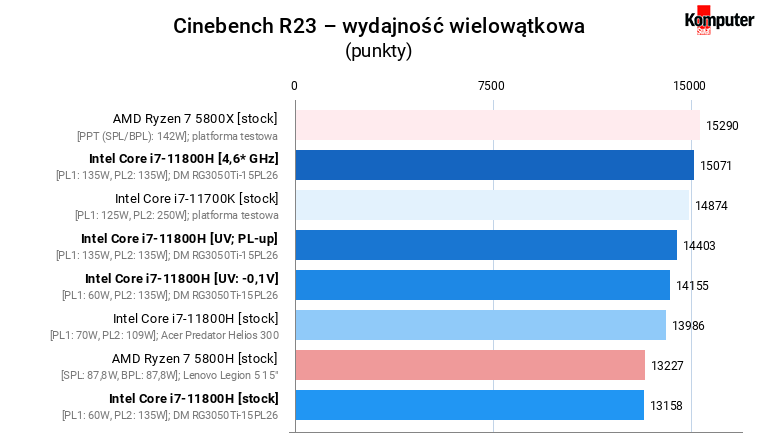
We can see even better results in longer applications where the main factor limiting performance is the long-term power limit. In the long-term performance test in a 10-minute Cinebench R23 MT loop, lowering the voltage offset alone increases the performance by more than 5% , thanks to which the Core i7-11800H in Dream Machines is slightly ahead of the identical processor operating in the Helios 300. However, an additional increase in the power limit ensures an increase in performance as much as 24% compared to the default settings! Thus, after our optimizations,Core i7-11800H operating with a power of about 80-85W guarantees a performance of over 12% higher than that provided by the Ryzen 7 5800H with a power limit of 87.8W in the Legion 5 and almost 6% higher than that of the desktop Core i7-11700K operating with up to 125W! On the other hand, increasing the maximum clock speed of all cores to 4.6 GHz (although, as we know, the actual clock speed is slightly lower) translates into a further increase in performance by about another 4 percentage points, which in total gives a higher efficiency by over 28%.
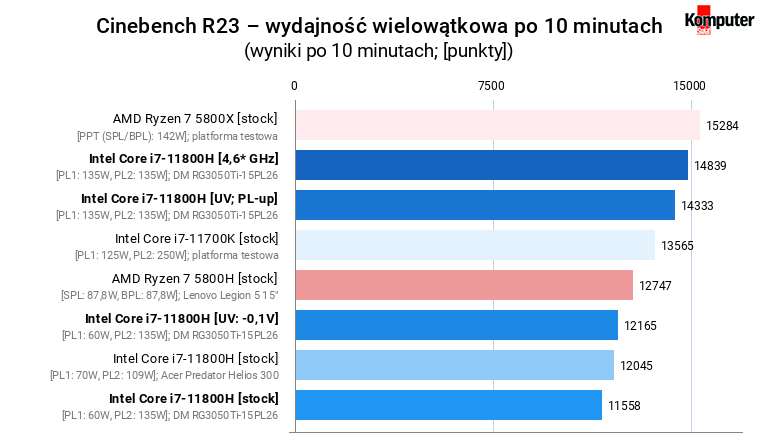
We see equally great results in other long-term applications. In the case of scene rendering in Blender, the reduction of the voltage offset alone increases the performance of the Core i7-11800H in the Dream Machines RG3050Ti-15PL26 by almost 6% , thanks to which the laptop provides higher performance than the Helios 300 equipped with an identical processor. An additional increase in the power cap gives even better results, and render completion is 18% faster than on the default settings! Thanks to this, the laptop fares much better than the Helios 300 or even the Lenovo Legion 5 with the Ryzen 7 5800H.
What’s more, The Core i7-11800H, while maintaining the average clock speed of about 4.2 GHz at 85W, provides performance at almost the same level as the Core i7-11700K, whose power during the identical use is, let’s recall, up to 125W (and initially reaches up to 250W!). Unfortunately, increasing the maximum clock speed to 4.6 GHz gives only a minimal further increase in performance (by about 3 percentage points, i.e. to a level higher by 21% compared to the initial value), which results from exceeding the temperature limit and lowering the clock speed to 4.3-4 , 4 GHz.
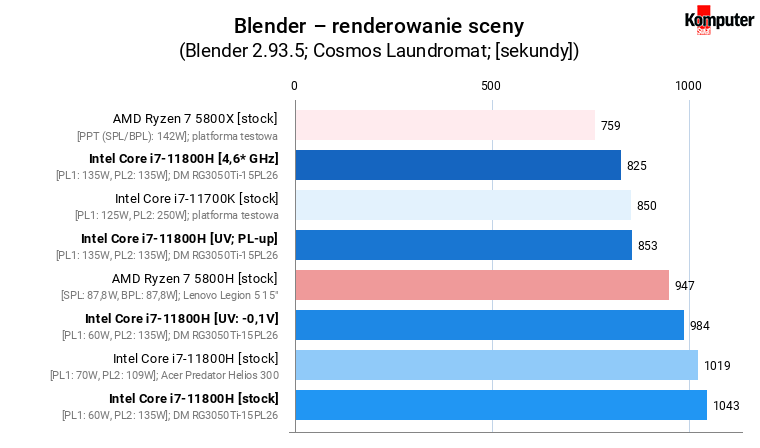
Only slightly less spectacular results are recorded in the x264 video encoding test. In this case , the voltage reduction alone improves the processor’s performance by just over 4% , thanks to which the Core i7-11800H in the RG3050Ti-15PL26 is equal to the performance of the same chip in the Helis 300. However, the additional increase in the power limit increases the performance by another 7 percentage points, which translates into performance is 11% higher than the factory capacity. As a result, the laptop provides higher performance than a desktop equipped with the Core i7-11700K and on the level of a desktop computer equipped with a Ryzen 7 5800X. On the other hand, the additional increase in the maximum clock speed when all cores are loaded already provides an over 17% increase in performance , which makesthe mobile i7-11800H offers performance by over 5% higher than the desktop Ryzen 7 5800X.
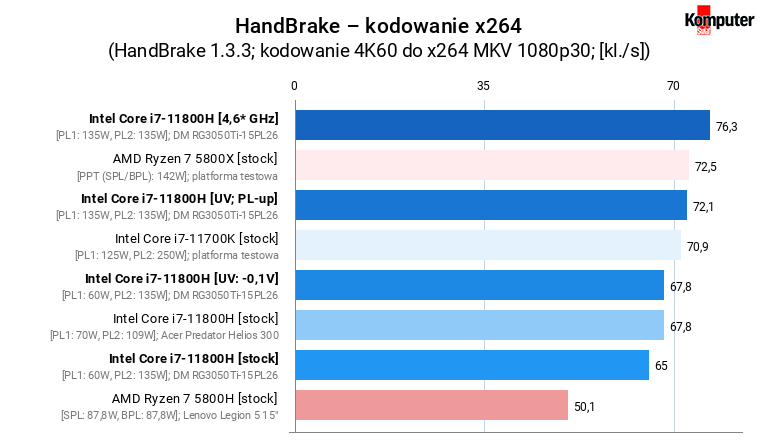
The situation is slightly different in the case of x265 video encoding. In this application, lowering the voltage improves the processor’s performance by only less than 3%. However, this is enough for the RG3050Ti-15PL26 to almost match the Helios 300 with an identical processor. On the other hand, a significantly greater increase in efficiency is provided by an additional increase in the power limit, thanks to which the efficiency increases by almost 19% compared to the factory settings.
As a result, the Core i7-11800H in the RG3050Ti-15PL26 provides over 6% higher performance than the Core i7-11700K and 5% higher than the Ryzen 7 5800X running on default desktop settings. However, this is still not the end of the possibilities of this mobile system;).Undervolting, increasing the power limit and increasing the maximum clock speed while loading all cores can increase performance by as much as 24%, thanks to which the Core i7-11800H can provide performance up to 10% higher than the desktop Ryzen 7 5800X! This is a level that Ryzen is unable to provide even after the OC.
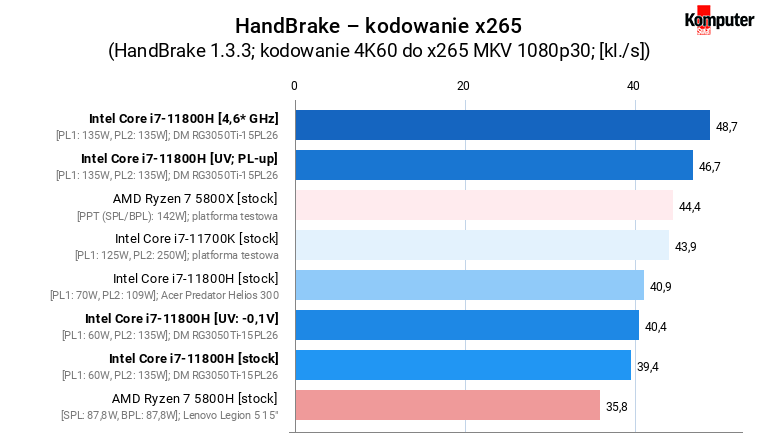
Intel Core i7-11800H – undervolting and overclocking – gaming results
In the case of games, the graphics chip generally has a greater impact on the final performance of the laptop. However, in the case of many titles, especially in FullHD resolution, the processor still plays a significant role. To see what performance increase we can count on, we tested the RG3050Ti-15PL26 with Core i7-11800H in several popular games. Below we present the factory results, after undervolting and simultaneously raising the power limit and under undervolting, raising the power limit and increasing the maximum clock speed . In addition, to compare which component has a greater impact on performance in a given game and settings, the graphs also include the results obtained after increasing the GPU and VRAM RTX 3050 Ti [85W] clock speed working with the processor with default and optimized settings.Unfortunately, the graphics layout in the Dream Machines laptop does not overclock. We managed to increase the GPU clock by 160 MHz, and the VRAM by 138 MHz.
![Dream Machines RG3050Ti-15PL26 - GPU-Z - RTX 3050 Ti [85W] specification after increasing GPU and VRAM clocking](https://www.bitcoinminershashrate.com/wp-content/uploads/2022/02/vksktkpTURBXy83OTBmNjZkZTRjYzk2NWE1YzE0YTU5MGE5YTc5NGJiZC5wbmeSlQLNAxQAwsOVAgDNAvjCww.png)
Dream Machines RG3050Ti-15PL26 – GPU-Z – RTX 3050 Ti [85W] specification after increasing GPU and VRAM clocking
It should also be remembered that in the case of laptops, the components, although separate, share a common power limit. Thus, undervolting CPU not only allows the processor to maintain a higher clock speed while maintaining the same power, but in games requiring higher GPU performance, it can also redirect the power saved by the CPU to the graphics system (for example as part of the Dynamic Boost 2.0 technique).
Unfortunately, in games, the increase in performance caused by undervoltage (and the less significant increase in the CPU power limit in such an application) is generally less noticeable. In Counter Strike: Global Offensive (very susceptible to processor performance) , both lowering the voltage offset and increasing the power limit, as well as an additional increase in the maximum clock speed translate into an almost 9% increase in the smoothness of the animation, while increasing the GPU and VRAM clock speed provides a bit lower growth, at the level of less than 6% . Of course, the best results are obtained when we apply both solutions – then we can count on the efficiency higher by almost 14%
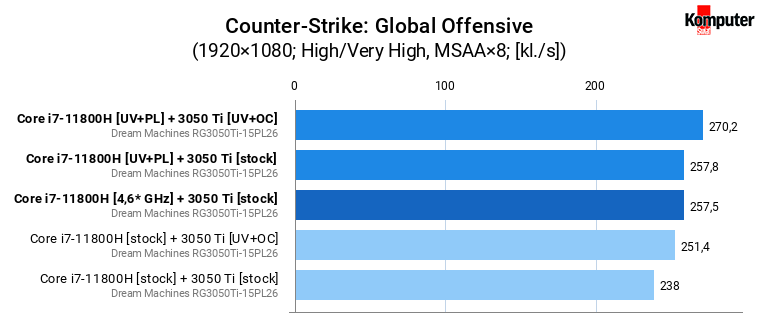
Dream Machines RG3050Ti-15PL26 – Counter-Strike Global Offensive
The same is the case with Fortnite and medium graphics quality settings. In this game, both lowering the voltage offset and increasing the power limit as well as increasing the maximum clock speed additionally provide about a 5% increase in performance. Minimally better results are achieved by undervolting and overclocking the GPU and VRAM, which provide performance approximately 6% higher than with the factory settings . Again , however, it is best to use both possibilities, which ensures a cumulative increase in performance of nearly 10%.
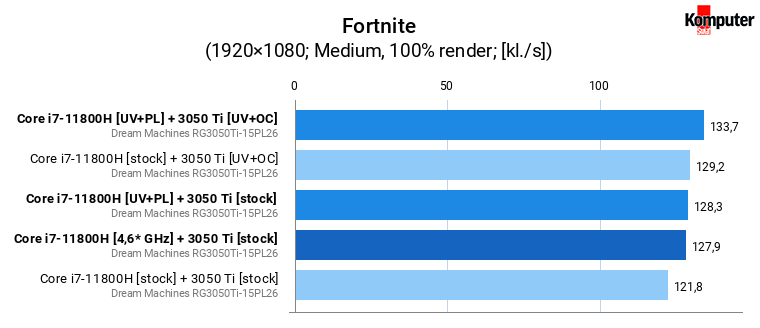
Dream Machines RG3050Ti-15PL26 – Fortnite
In the case of GTA V, again, both lowering the voltage offset and increasing the power limit, as well as an additional increase in the maximum clock speed provide an identical, approximately 3% increase in performance . Virtually the same, less than 3% increase is also ensured by the undervolting and overclocking of the GPU and VRAM itself . On the other hand, the use of both possibilities gives a total increase in efficiency of about 6%.
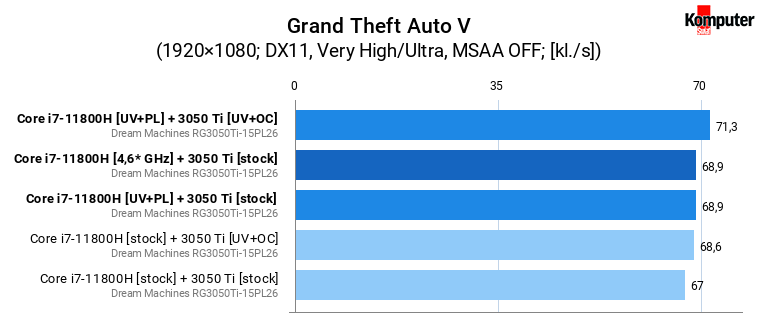
Dream Machines RG3050Ti-15PL26 – Grand Theft Auto V
An interesting case is Shadwo of the Tomb Raider. In this game , undervolting and increasing the power cap gives a performance increase of over 3% – slightly greater than the additional increase in maximum clock speed. On the other hand, the mere increase of the GPU and VRAM clock speeds translates into a performance higher by only 2%. However, undervolting the CPU (resulting in maintaining the desired, sufficient clock speed and processor performance at a power lower by a few watts), thanks to the Dynamic Boost technique, allowed the overclocked GPU to boost even higher, which translated into a total almost 8% increase in performance – greater than it would appear from independent simultaneous CPU undervoltage and GPU and VRAM timing boost.
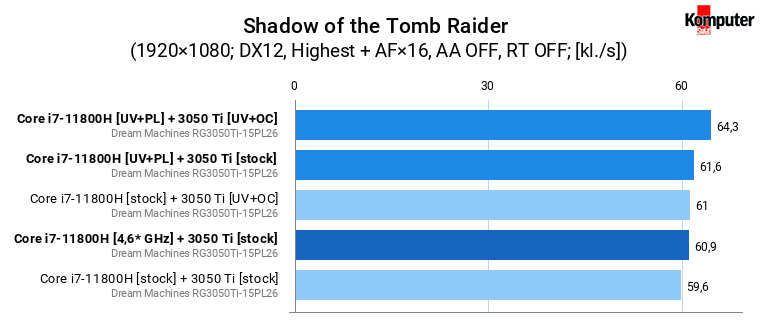
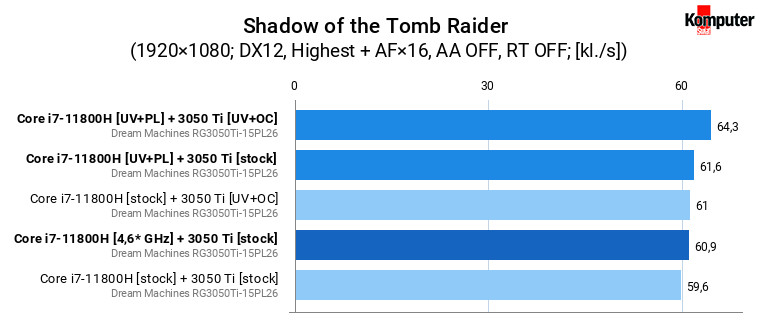
Dream Machines RG3050Ti-15PL26 – Shadow of the Tomb Raider
The Witcher 3 (in a given test site!) Is an example of a game where increasing the efficiency of the processor has virtually no impact on performance. Contrary to GPU and VRAM overclocking, which provides an almost 7% increase in performance.
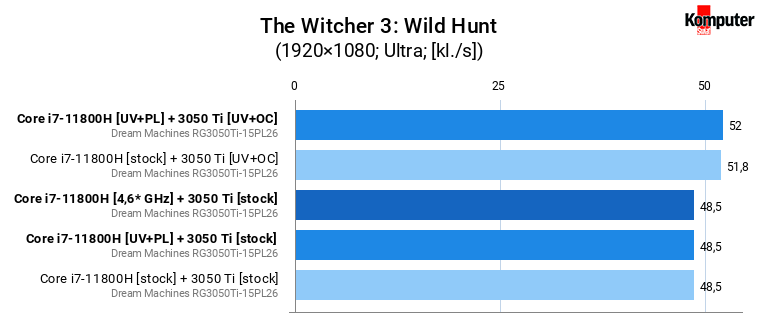
Intel Core i7-11800H – undervolting i overclocking
If the laptop is often used for demanding tasks, such as video encoding or rendering, in which processor performance plays a key role, lowering the voltage, increasing power limits and increasing the clock speed for all cores is a valuable (although free;)) way to increase performance .
Reducing the time needed to complete a task by almost 30% is a noticeable change and can translate into greater efficiency at work or more free time, and a laptop with a mobile Core i7-11800H can confidently replace a desktop computer equipped with an almost top Intel 11 processor. generation, such as Core i7-11700K or the extremely efficient and energy-efficient Ryzen 7 5800X. However, while the undervolting itself does not cause major inconveniences (although it is not always effective enough), increasing the power limits and clock speeds of the processor is associated with a significant increase in the amount of heat emitted , and thus heating components and a noisy cooling system . These are unfortunately problems that must be reckoned with.







